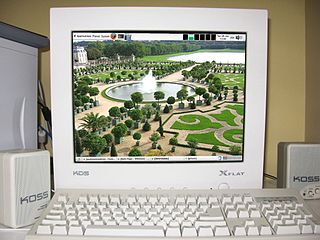
A design is a concept of either an object, a process, or a system that is specific and, in most cases, detailed. Design refers to something that is or has been intentionally created by a thinking agent, though it is sometimes used to refer to the nature of something. The verb to design expresses the process of developing a design. In some cases, the direct construction of an object without an explicit prior plan may also be considered to be a design. The design usually has to satisfy certain goals and constraints; may take into account aesthetic, functional, economic, or socio-political considerations; and is expected to interact with a certain environment. Typical examples of designs include architectural and engineering drawings, circuit diagrams, sewing patterns and less tangible artefacts such as business process models.

Anthony Stafford Beer was a British theorist, consultant and professor at the Manchester Business School. He is best known for his work in the fields of operational research and management cybernetics.

Industrial design is a process of design applied to physical products that are to be manufactured by mass production. It is the creative act of determining and defining a product's form and features, which takes place in advance of the manufacture or production of the product. It consists purely of repeated, often automated, replication, while craft-based design is a process or approach in which the form of the product is determined by the product's creator largely concurrent with the act of its production.
Interaction design, often abbreviated as IxD, is "the practice of designing interactive digital products, environments, systems, and services." While interaction design has an interest in form, its main area of focus rests on behavior. Rather than analyzing how things are, interaction design synthesizes and imagines things as they could be. This element of interaction design is what characterizes IxD as a design field, as opposed to a science or engineering field.
Design research was originally constituted as primarily research into the process of design, developing from work in design methods, but the concept has been expanded to include research embedded within the process of design, including work concerned with the context of designing and research-based design practice. The concept retains a sense of generality, aimed at understanding and improving design processes and practices quite broadly, rather than developing domain-specific knowledge within any professional field of design.

A graphic designer is a professional within the graphic design and graphic arts industry who assembles together images, typography, or motion graphics to create a piece of design. A graphic designer creates the graphics primarily for published, printed, or electronic media, such as brochures and advertising. They are also sometimes responsible for typesetting, illustration, user interfaces. A core responsibility of the designer's job is to present information in a way that is both accessible and memorable.
Service design is the activity of planning and arranging people, infrastructure, communication and material components of a service in order to improve its quality, and the interaction between the service provider and its users. Service design may function as a way to inform changes to an existing service or create a new service entirely.
Design methods are procedures, techniques, aids, or tools for designing. They offer a number of different kinds of activities that a designer might use within an overall design process. Conventional procedures of design, such as drawing, can be regarded as design methods, but since the 1950s new procedures have been developed that are more usually grouped together under the name of "design methods". What design methods have in common is that they "are attempts to make public the hitherto private thinking of designers; to externalise the design process".

Design management is a field of inquiry that uses project management, design, strategy, and supply chain techniques to control a creative process, support a culture of creativity, and build a structure and organization for design. The objective of design management is to develop and maintain an efficient business environment in which an organization can achieve its strategic and mission goals through design. Design management is a comprehensive activity at all levels of business, from the discovery phase to the execution phase. "Simply put, design management is the business side of design. Design management encompasses the ongoing processes, business decisions, and strategies that enable innovation and create effectively-designed products, services, communications, environments, and brands that enhance our quality of life and provide organizational success." The discipline of design management overlaps with marketing management, operations management, and strategic management.
Design thinking refers to the set of cognitive, strategic and practical procedures used by designers in the process of designing, and to the body of knowledge that has been developed about how people reason when engaging with design problems.
Human-centered design is an approach to problem-solving commonly used in process, product, service and system design, management, and engineering frameworks that develops solutions to problems by involving the human perspective in all steps of the problem-solving process. Human involvement typically takes place in initially observing the problem within context, brainstorming, conceptualizing, developing of concepts and implementing the solution.

Human–computer interaction (HCI) is research in the design and the use of computer technology, which focuses on the interfaces between people (users) and computers. HCI researchers observe the ways humans interact with computers and design technologies that allow humans to interact with computers in novel ways. A device that allows interaction between human being and a computer is known as a "Human-computer Interface (HCI)".

David John Bartholomew was a British statistician who was president of the Royal Statistical Society between 1993 and 1995. He was professor of statistics at the London School of Economics between 1973 and 1996.
Perry J. Kaufman is an American systematic trader, rocket scientist, index developer, and quantitative financial theorist. He is considered a leading expert in the development of fully algorithmic trading programs.
The Design Research Society (DRS), founded in the United Kingdom in 1966, is an international society for developing and supporting the interests of the design research community. The primary purpose of the DRS, as embodied in its first statement of rules, is to promote ‘the study of and research into the process of designing in all its many fields'. This established the intention of being an interdisciplinary learned society, taking a scholarly and domain independent view of the process of designing. Membership is open to anyone interested in design research, and members with established experience and a strong background in design research may apply to be elected as a DRS Fellow.
Transgenerational design is the practice of making products and environments compatible with those physical and sensory impairments associated with human aging and which limit major activities of daily living. The term transgenerational design was coined in 1986, by Syracuse University industrial design professor James J. Pirkl to describe and identify products and environments that accommodate, and appeal to, the widest spectrum of those who would use them—the young, the old, the able, the disabled—without penalty to any group. The transgenerational design concept emerged from his federally funded design-for-aging research project, Industrial design Accommodations: A Transgenerational Perspective. The project's two seminal 1988 publications provided detailed information about the aging process; informed and sensitized industrial design professionals and design students about the realities of human aging; and offered a useful set of guidelines and strategies for designing products that accommodate the changing needs of people of all ages and abilities.

Human factors and ergonomics is the application of psychological and physiological principles to the engineering and design of products, processes, and systems. Primary goals of human factors engineering are to reduce human error, increase productivity and system availability, and enhance safety, health and comfort with a specific focus on the interaction between the human and equipment.
Nigel Cross is a British academic, a design researcher and educator, Emeritus Professor of Design Studies at The Open University, United Kingdom, where he was responsible for developing the first distance-learning courses in design in the early 1970s. He was an editor of the journal Design Studies since its inception in 1979 and is now Emeritus Editor in Chief. Cross helped clarify and develop the concept of design thinking related to the development of design as an academic discipline. He is one of the key people of the Design Research Society.
The Katharine Burr Blodgett Medal and Prize is a gold medal awarded annually by the Institute of Physics to "recognise contributions to the organisation or application of physics in an industrial or commercial context." The medal is accompanied by a prize of £1000.
Jonathan Vivian Rosenhead is a British mathematician, operational researcher and Labour Party activist.








